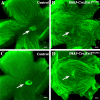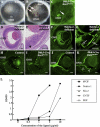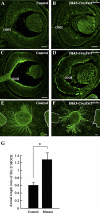Heparan sulfate regulates intraretinal axon pathfinding by retinal ganglion cells
- PMID: 21743013
- PMCID: PMC3176022
- DOI: 10.1167/iovs.11-7559
Heparan sulfate regulates intraretinal axon pathfinding by retinal ganglion cells
Abstract
PURPOSE. Heparan sulfate (HS) is abundantly expressed in the developing neural retina; however, its role in the intraretinal axon guidance of retinal ganglion cells (RGCs) remains unclear. In this study, the authors examined whether HS was essential for the axon guidance of RGCs toward the optic nerve head. METHODS. The authors conditionally ablated the gene encoding the exostosin-1 (Ext1) enzyme, using the dickkopf homolog 3 (Dkk3)-Cre transgene, which disrupted HS expression in the mouse retina during directed pathfinding by RGC axons toward the optic nerve head. In situ hybridization, immunohistochemistry, DiI tracing, binding assay, and retinal explant assays were performed to evaluate the phenotypes of the mutants and the roles of HS in intraretinal axon guidance. RESULTS. Despite no gross abnormality in RGC distribution, the mutant RGC axons exhibited severe intraretinal guidance errors, including optic nerve hypoplasia, ectopic axon penetration through the full thickness of the neural retina and into the subretinal space, and disturbance of the centrifugal projection of RGC axons toward the optic nerve head. These abnormal phenotypes shared similarities with the RGC axon misguidance caused by mutations of genes encoding Netrin-1 and Slit-1/2. Explant assays revealed that the mutant RGCs exhibited disturbed Netrin-1-dependent axon outgrowth and Slit-2-dependent repulsion. CONCLUSIONS. The present study demonstrated that RGC axon projection toward the optic nerve head requires the expression of HS in the neural retina, suggesting that HS in the retina functions as an essential modulator of Netrin-1 and Slit-mediated intraretinal RGC axon guidance.
Figures








Similar articles
-
Kinase independent function of EphB receptors in retinal axon pathfinding to the optic disc from dorsal but not ventral retina.Development. 2000 Mar;127(6):1231-41. doi: 10.1242/dev.127.6.1231. Development. 2000. PMID: 10683176
-
Altered midline axon pathways and ectopic neurons in the developing hypothalamus of netrin-1- and DCC-deficient mice.J Neurosci. 1999 Nov 15;19(22):9900-12. doi: 10.1523/JNEUROSCI.19-22-09900.1999. J Neurosci. 1999. PMID: 10559399 Free PMC article.
-
Slit proteins regulate distinct aspects of retinal ganglion cell axon guidance within dorsal and ventral retina.J Neurosci. 2006 Aug 2;26(31):8082-91. doi: 10.1523/JNEUROSCI.1342-06.2006. J Neurosci. 2006. PMID: 16885222 Free PMC article.
-
Intraretinal projection of retinal ganglion cell axons as a model system for studying axon navigation.Brain Res. 2008 Feb 4;1192:165-77. doi: 10.1016/j.brainres.2007.01.116. Epub 2007 Feb 2. Brain Res. 2008. PMID: 17320832 Free PMC article. Review.
-
Ganglion cell axon pathfinding in the retina and optic nerve.Semin Cell Dev Biol. 2004 Feb;15(1):125-36. doi: 10.1016/j.semcdb.2003.09.006. Semin Cell Dev Biol. 2004. PMID: 15036215 Review.
Cited by
-
Panels of chemically-modified heparin polysaccharides and natural heparan sulfate saccharides both exhibit differences in binding to Slit and Robo, as well as variation between protein binding and cellular activity.Mol Biosyst. 2016 Oct 20;12(10):3166-75. doi: 10.1039/c6mb00432f. Epub 2016 Aug 9. Mol Biosyst. 2016. PMID: 27502551 Free PMC article.
-
Functional Requirements for Heparan Sulfate Biosynthesis in Morphogenesis and Nervous System Development in C. elegans.PLoS Genet. 2017 Jan 9;13(1):e1006525. doi: 10.1371/journal.pgen.1006525. eCollection 2017 Jan. PLoS Genet. 2017. PMID: 28068429 Free PMC article.
-
Connecting the retina to the brain.ASN Neuro. 2014 Dec 12;6(6):1759091414562107. doi: 10.1177/1759091414562107. Print 2014. ASN Neuro. 2014. PMID: 25504540 Free PMC article. Review.
-
A roundabout way to cancer.Adv Cancer Res. 2012;114:187-235. doi: 10.1016/B978-0-12-386503-8.00005-3. Adv Cancer Res. 2012. PMID: 22588058 Free PMC article. Review.
-
A Comparison of Different Slicing Planes in Preservation of Major Hippocampal Pathway Fibers in the Mouse.Front Neuroanat. 2017 Nov 21;11:107. doi: 10.3389/fnana.2017.00107. eCollection 2017. Front Neuroanat. 2017. PMID: 29201002 Free PMC article.
References
-
- Harada T, Harada C, Parada LF. Molecular regulation of visual system development: more than meets the eye. Genes Dev. 2007;21:367–378 - PubMed
-
- Inatani M. Molecular mechanisms of optic axon guidance. Naturwissenschaften. 2005;92:549–561 - PubMed
-
- Deiner MS, Kennedy TE, Fazeli A, Serafini T, Tessier-Lavigne M, Sretavan DW. Netrin-1 and DCC mediate axon guidance locally at the optic disc: loss of function leads to optic nerve hypoplasia. Neuron. 1997;19:575–589 - PubMed
-
- Birgbauer E, Cowan CA, Sretavan DW, Henkemeyer M. Kinase independent function of EphB receptors in retinal axon pathfinding to the optic disc from dorsal but not ventral retina. Development. 2000;127:1231–1241 - PubMed
MeSH terms
Substances
Grants and funding
LinkOut - more resources
Full Text Sources
Molecular Biology Databases
Miscellaneous

